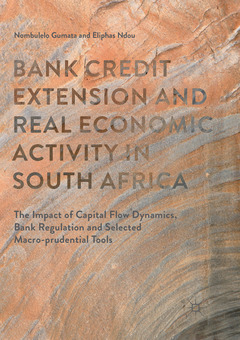Bank Credit Extension and Real Economic Activity in South Africa, Softcover reprint of the original 1st ed. 2017 The Impact of Capital Flow Dynamics, Bank Regulation and Selected Macro-prudential Tools
Auteurs : Gumata Nombulelo, Ndou Eliphas

This book presents empirical evidence that supports and facilitates a practical, integrated approach to how bank regulatory and selected macro-prudential tools interact with monetary policy to achieve price and financial stability. The empirical results contained in various chapters accompany in-depth historical analysis and counterfactual scenarios that enable proper policy evaluation and the interaction of bank regulatory, macro-prudential and monetary policy tools in South Africa. The presented evidence also identifies financial asset boom and bust episodes and the associated costly output losses. In addition, the authors explore the amplification of credit dynamics by commodity prices and sector credit re-allocation due to capital inflows shocks. The book?s empirical analysis uses a wide range of statistical and econometric approaches on granular data and economic variables to derive policy implications and recommendations. This in-depth quantitative analysis includesdetermining inverse transmission of global liquidity, as well as the effects of capital flows, lending-rate margins, financial regulatory uncertainty, the National Credit Act, bank capital-adequacy ratios, bank loan loss provisions, loan-to-value ratios and repayment-to-income ratios on the macro-economy.
Nombulelo Gumata holds a Master’s degree in Economics from the University of Johannesburg, South Africa. She in an economist at the Reserve Bank of South Africa and a part-time lecturer/tutor at the Centre for Education in Economics and Finance Africa (CEEF.Africa). CEEF.Africa supports students who study with the University of London for degrees and diplomas in Economics and Finance. She is the co-author of “Global Growth and Financial Spill-Overs and South African Economy” (Palgrave, 2015).
Eliphas Ndou holds a Bachelor of Science in mathematical statistics and economics, a Bachelor of Economic Science (Honours), a Master of commerce and a PhD in economics from the University of the Witwatersrand, South Africa. He is an economist at the South African Reserve Bank and a lecturer at the University of the Witwatersrand. He is the co-author of “Monetary policy and the Economy in South Africa” (Palgrave, 2013) and “Global Growth and Financial Spill-Overs and SouthAfrican Economy” (Palgrave, 2015).
Date de parution : 08-2018
Ouvrage de 582 p.
14.8x21 cm
Date de parution : 03-2017
Ouvrage de 582 p.
14.8x21 cm



